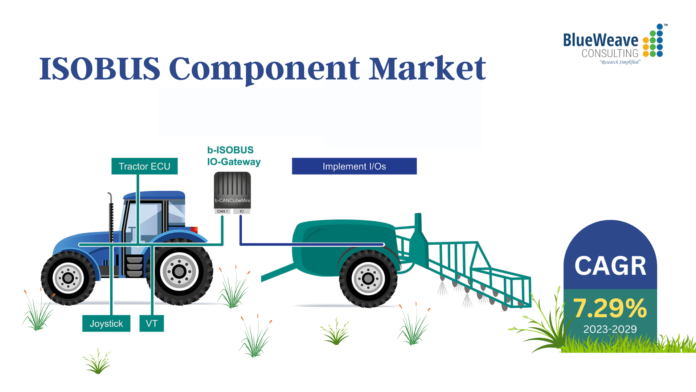Global ISOBUS component marketis flourishing because of an increasing trend toward automation and mechanization in agriculture and a high demand for precision farming technologies.
BlueWeave Consulting, a leading strategic consulting and market research firm, in its recent study, estimated global ISOBUS component marketsize at USD 637.41 million in 2022. During the forecast period between 2023 and 2029, BlueWeave expects global ISOBUS component marketsize to grow at a significant CAGR of 7.29% reaching a value of USD 1,038.33 million by 2029. Major growth drivers for the global ISOBUS component market include a rising need to solve the issue of equipment incompatibility among different manufacturers. The ISOBUS technology provides a solution to this problem by allowing a virtual terminal (VT) to control multiple implements from various companies simultaneously. The increasing demand for agricultural machinery that can perform multiple tasks and enhance productivity is propelling the demand for ISOBUS components. Farmers are increasingly adopting precision farming technologies to improve crop yields and optimize resource usage, which requires advanced machinery with effective communication systems. Also, the use of digital farming technologies such as smart farming, autonomous farming, and precision farming is on the rise, and these technologies depend on advanced machinery with efficient communication systems. As a result, the demand for ISOBUS components is growing. However, high initial investment costs for implementing ISOBUS technology and limited compatibility of ISOBUS components with equipment from different manufacturers is anticipated to restrain the growth of the market during the period in analysis.
Global ISOBUS Component Market – Overview
ISOBUS, also known as ISO 11783, is a software standard established by the International Organization of Standardization. This standard defines the software used to enable interoperability and communication between various agricultural implements, including sensors, control units, cloud servers, and display units, whether they are mounted on the tractor or not. The first tractor equipped with ISOBUS compliant equipment was introduced in the early 1990s. Since then, there have been significant advancements in ISOBUS and other agricultural technologies. Although still in the growth phase, ISOBUS has a promising future ahead. The connectivity achieved between different agricultural implements through ISOBUS equipment has been crucial in deploying digital solutions that can enhance field productivity and efficiency.
Sample Request @https://www.blueweaveconsulting.com/report/isobus-component-market/report-sample
Impact of COVID-19 on Global ISOBUS Component Market
COVID-19 had a dual impact on the global ISOBUS component market. On the one hand, the pandemic disrupted supply chains and manufacturing operations, leading to production and delivery delays. It caused some projects to be put on hold and resulted in a decline in demand for ISOBUS components. The pandemic also led to a decline in agricultural activity, with farmers facing difficulties in transporting their crops to the market and in obtaining the necessary inputs, such as fertilizers and pesticides. On the other hand, the pandemic also accelerated the adoption of digital farming technologies, such as precision farming, which rely on advanced machinery with efficient communication systems. As a result, the demand for ISOBUS components continued to grow, driven by the need to increase agricultural productivity and efficiency. The pandemic also highlighted the importance of food security, which led to increased government support for the agricultural sector, providing a boost to the growth of global ISOBUS component market.
Global ISOBUS Component Market – By Application
By application, the global ISOBUS component market is divided into Tractor, Planter & Seeder, and Harvester segments. The tractor application segment is expected to hold the highest share in the global ISOBUS component market. The tractors are the most commonly used agricultural machinery, and they typically require the use of several different implements, such as plows, cultivators, and seeders, in order to perform a range of tasks. ISOBUS technology enables efficient communication and control between the tractor and these implements, improving overall productivity and reducing downtime. Also, the adoption of ISOBUS technology is also being driven by the increasing demand for precision farming, which requires the use of advanced machinery and technologies to optimize crop yields and reduce waste. Tractors equipped with ISOBUS technology play a critical role in enabling precision farming, making them a vital segment in the global ISOBUS component market.
Competitive Landscape
Major players operating in global ISOBUS component market include AGCO Corporation, Claas KGaA mbH, CNH Industrial N.V., Deere & Company, Topcon Positioning Systems, Inc., Trimble, Inc., Raven Industries, Inc., DICKEY-john Corporation, Kverneland Group, Reichhardt GmbH, Bosch Rexroth AG, AG Leader Technology, TeeJet Technologies, Precision Planting LLC, and Hemisphere GNSS Inc. To further enhance their market share, these companies employ various strategies, including mergers and acquisitions, partnerships, joint ventures, license agreements, and new product launches.
The in-depth analysis of the report provides information about growth potential, upcoming trends, and statistics of Global ISOBUS Component Market. It also highlights the factors driving forecasts of total market size. The report promises to provide recent technology trends in Global ISOBUS Component Market and industry insights to help decision-makers make sound strategic decisions. Furthermore, the report also analyzes the growth drivers, challenges, and competitive dynamics of the market.
Contact Us:
BlueWeave Research Blog
Phone No: +1 866 658 6826
Email: info@blueweaveconsulting.com














